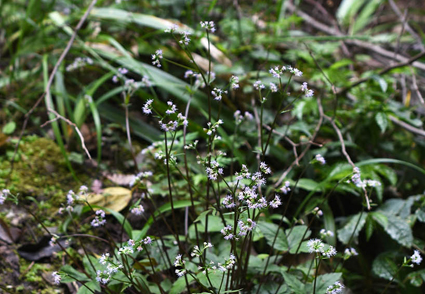Abstract
Based on critical observations on herbarium specimens (including type material) and living plants in the wild, we demonstrate that Sanicula lamelligera (Apiaceae) is highly variable in character of basal leaves, branches of inflorescences, and character of fruits. We therefore accept some previous synonyms of this species, including S. ichangensis, S. lamelligera var. wakayamensis, S. orthacantha var. longispina, S. satsumana, and S. yunnanensis, and further reduce S. orthacantha var. pumila, and S. pengshuiensis to its synonymy. Lectotypification is proposed for S. lamelligera var. wakayamensis and S. orthacantha var. pumila.
References
Boissieu, H. de (1906) Note sur quelques Ombellifères de la Chine, d’après les collections du Muséum d’Histoire naturelle de Paris. Bulletin de la Société Botanique de France 53: 418–437. https://doi.org/10.1080/00378941.1906.10831189
Diels, L. (1901) Die Flora von Central-China (Schluss). Botanische Jahrbücher fur Systematik, Pflanzengeschichte und Pflanzengeographie 29: 577–659.
Forbes, F.B. & Hemsley, W.B. (1886–1888) An enumeration of all the plants known from China proper, Formosa, Hainan, Corea, the Luchu archipelago, and the island of Hongkong, together with their distribution and synonymy. The Journal of the Linnean Society 23: 1–489. https://doi.org/10.1111/j.1095-8339.1886.tb00530.x
Franchet, A. (1894) Notes sur quelques Ombellifères du Yunnan. Bulletin de la Socieìteì Philomathique de Paris 8 (6): 106–146.
Hance, H.F. (1878) Spicilegia florae Sinensis: diagnoses of new and habitats of rare or hitherto unrecorded, Chinese plants. Journal of Botany, British and Foreign 16: 6–15.
Handel-Mazzetti, H.F. (1933) Symbolae Sinicae, vol. 7 (3). Julius Springer, Vienna, pp. 706–730.
Hayata, B. (1908) Flora montana Formosae: an enumeration of the plants found on Mt. Morrison, the central chain, and other mountainous regions of Formosa at altitudes of 3,000–13,000 ft. Journal of the College of Science, Imperial University of Tokyo 25 (19): 1–260. https://doi.org/10.5962/bhl.title.10880
Hiroe, M. (1979) Umbelliferae of World. Ariake Book Company, Matsuo Biru, Tokyo, 2128 pp.
Kitamura, S. & Murata, G. (1962) New names and new conceptions adopted in our colored Illustrations of Herbaceous Plants of Japan II (Choripetalae). Acta Phytotaxonomica et Geobotanica 20: 195–208.
Linnaeus, C. (1753) Species Plantarum. Laurentii Salvii, Holmiae. 1200 pp.
Liu, Q.X., Hui, H., Li, B.Y. & Pan, Z.H. (2002) Comparative anatomical studies on the fruits of Saniculoideae in China (Umbelliferae) and its systematic significance. Journal of Plant Resources and Environment 11 (4): 1–8.
Liu, S.L. (1979) Sanicula L. In: Shan, R.H. & Sheh, M.L. (Eds.) Flora Reipublicae Popularis Sinicae, vol. 55 (1). Science Press, Beijing, pp. 35–63.
Liu, S.L. (1997) Sanicula L. In: Wu, Z.Y. (Ed.) Flora Yunnanica, vol. 7. Science Press, Beijing, pp. 372–380.
Masamune, G. (1941) Miscellaneous notes on the Flora of the eastern Asia XX. Transactions, Natural History Society of Formosa 31: 339–344.
Matsumura, J. & Hayata, B. (1906) Enumeratio plantarum Formosanarum. Journal of Science Imperial University of Tokyo 22: 1–702.
Matsumura, T. (1898) Notes on some Liu-Kiu plants. Botanical Magazine Tokyo 12: 1–3. https://doi.org/10.15281/jplantres1887.12.131_en1
Maximowicz, C.J. (1867) Diagnoses breves plantarum novarum Japoniae et Mandshuriae. Bulletin de l’Academie Imperiale des Sciences de St.-Petersbourg 11: 429–432. https://doi.org/10.5962/bhl.title.46306
Maximowicz, C.J. (1886) Diagnoses de nouvelles plantes de I’Asie. VI . Bulletin de l’Academie Imperiale des Sciences de St.-Petersbourg 3 (32): 12–121.
Pimenov, M.G. (2017) Updated checklist of Chinese Umbelliferae: nomenclature, synonymy, typification, distribution. Turczaninowia 20: 106–239. https://doi.org/10.14258/turczaninowia.20.2.9
Shan, R.H. & Constance, L. (1951) The Genus Sanicula (Umbelliferae) in the Old World and the New. University of California Publications in Botany 25: 1–78.
Shan, R.H. (1936) Studies on Umbelliferae of China, I (Hydrocotyloideae, Saniculoideae). Sinensia 7: 477–489.
Sheh, M.L. & Phillippe, L.R. (2005) Sanicula L. In: Sheh, M.L., Pu, F.D., Pan, Z.H., Watson, M.F., Cannon, J.F.M., Smith, I.H., Kljuykov, E.V., Phillippe, L.R. & Pimenov, M.G. (Eds.) Flora of China, vol. 14. Science Press & Missouri Botanical Garden Press, Beijing & St. Louis, pp. 19–24.
Sheh, M.L., Liu, X.T. & Liu, Z.Y. (1991) Two new species of Sanicula L. (Umbelliferae) from China. Acta Phytotaxonomica Sinica 29: 469–473.
Turland, N.J., Wiersema, J.H., Barrie, F.R., Greuter, W., Hawksworth, D.L., Herendeen, P.S., Knapp, S., Kusber, W.-H., Li, D.-Z., Marhold, K., May, T.W., McNeill, J., Monro, A.M., Prado, J., Price, M.J. & Smith, G.F. (2018) International Code of Nomenclature for algae, fungi, and plants (Shenzhen Code). Regnum Vegetabile 159. Koeltz Botanical Books, Glashütten, 254 pp. https://doi.org/10.12705/Code.2018
Wang, W.T. (1993) Vascular Plants of the Hengduan Mountains, vol. 1. Science Press, Beijing, 1363 pp.
Wolff, H. (1913) Umbelliferae-Saniculoideae. In: Engler, A. (Ed.) Das Pflanzenreich, vol. 4. Wilhelm Engelmann, Leipzig & Berlin, pp. 1–305.
Wu, C.Y. (1984) Index Florae Yunnanensis, vol. 1. Yunnan People’s Publishing House, Kunming, 1070 pp.
Yabe, Y. (1902) Revisio Umbelliferarum Japonicarum. The Journal of the College of Science, Imperial University of Tokyo, Japan 16 (2): 1–108.
Yang, M.Z. (1989) Sanicula L. In: Li, Y.K. (Ed.) Flora Guizhouensis, vol. 4. Guizhou People’s Publishing House, Guiyang, pp. 360–367.


